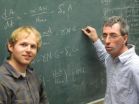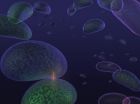Elusive platelet count and limb development gene discovered
New study will enable better antenatal diagnosis for sufferers of rare blood and skeletal disorder
2012-02-27
(Press-News.org) Researchers have identified an elusive gene responsible for Thrombocytopenia with Absent Radii (TAR), a rare inherited blood and skeletal disorder. As a result, this research is now being transformed into a medical test that allows prenatal diagnosis and genetic counselling in affected families.
The team used genetic sequencing to discover that TAR results from low levels of the protein called Y14. They found that the syndrome occurs by a unique inherited mechanism.
Platelets are the second most abundant cell in the blood. Their main task is to survey the blood vessel wall for damage and to plug and repair it where required. Some people are born with low numbers of platelets and these rare conditions are thought to be inherited. TAR syndrome combines the unique features of low platelet count and prominent bleeding, especially in infancy, and skeletal abnormalities affecting the upper limb ranging from absence of the radial bone in the forearm to virtually total absence of upper limb. The genetic basis of TAR syndrome has eluded researchers for 50 years.
"Without the use of modern genomics technologies, the discovery of this unexpected mechanism of disease inheritance would have been much more difficult", said Dr Cornelis Albers, from the Sanger Institute and the University of Cambridge. "To achieve our latest findings, we deciphered about 40 million letters of genetic code in five patients."
Many people with TAR were known to have a deletion in one copy of chromosome 1, but this was thought not to be the whole story because parents who carry the same deletion are not suffering from TAR: other variants had to be involved. The team sequenced the genomes of people affected by the disorder who also carried the deletion and discovered that the vast majority of them had one of two variants of a gene called RBM8A. They found that when the genetic deletion and one of the variants are co-inherited by a child, TAR results.
RBM8A controls the production of the protein Y14. They found that the combination of the genetic deletion of one copy of the RBM8A gene and the variants on the other copy greatly reduces the level of Y14. The team concluded that it is low levels of Y14 that affect platelet formation and cause TAR disorder.
"The lack of production of adequate amounts of the protein Y14 in TAR patients only seems to effect the formation of platelets but not of other blood cells." said Dr Cedric Ghevaert from the University of Cambridge. "We have shed some light on how some inherited disorders can present with such striking features associating seemingly unconnected characteristics such as skeletal and blood defects"
This is the first human disorder identified to be caused by a presumed defect of the Exon Junction Complex, part of the cellular machinery that contributes to producing messages that direct protein production. This study opens the path that could lead to the identification of the genetic basis of other similar inherited syndromes, which will help improvements in diagnosis, genetic counselling and patient care in the NHS and beyond.
"The discovery of the gene for TAR will make it simpler to diagnose more accurately future cases with a simple DNA test. This new test is currently being developed for the NHS as part of the international ThromboGenomics initiative led by Professor Ouwehand" commented Dr Ruth Newbury-Ecob, Honorary Reader in Medical Genetics and Consultant in Clinical Genetics at the University of Bristol Hospitals.
###
Notes to Editors
The findings were made following a collaborative study by the NHS Blood and Transplant platelet research team at the University of Cambridge and the Wellcome Trust Sanger Institute, which is led by Dr Cedric Ghevaert and Professor Willem Ouwehand. The Cambridge researchers joined forces with Dr Ruth Newbury-Ecob from the University of Bristol and worked together with various other European research partners from Belgium, France, Germany and the Netherlands.
Publication
Nature Genetics website, 26 February 2012
Albers et al 'Compound inheritance of a low-frequency regulatory SNP and a rare null mutation in exon-junction complex subunit RBM8A causes TAR syndrome'
DOI 10.1038/ng.1083
Funding
The platelet research team in Cambridge is supported by the British Heart Foundation, the European Commission, the National Institute for Health Research for England (NIHR), NHS Blood and Transplant and the Wellcome Trust.
Dr Cedric Ghevaert and Prof Willem Ouwehand are also consultant Haematologists for NHS Blood and Transplant (NHSBT). NHSBT collects blood and platelets from non-remunerated volunteer donors. Every day about 8,000 units of blood are needed by the NHS and 1100 platelet concentrates. For the latter about 600 donors attend a special clinic at which platelets are harvested from the blood of the donor by a process called apheresis.
The National Institute for Health Research (NIHR) http://www.nihr.ac.uk) is the major governmental fund provider for clinical translational research in the NHS. The mission of the NIHR is to maintain a health research system in which the NHS supports outstanding individuals, working in world-class facilities, conducting leading-edge research, focussed on the needs of patients and the public.
The Wellcome Trust is a global charity dedicated to achieving extraordinary improvements in human and animal health. It supports the brightest minds in biomedical research and the medical humanities. The Trust's breadth of support includes public engagement, education and the application of research to improve health. It is independent of both political and commercial interests. www.wellcome.ac.uk
The Wellcome Trust Sanger Institute, which receives the majority of its funding from the Wellcome Trust, was founded in 1992. The Institute is responsible for the completion of the sequence of approximately one-third of the human genome as well as genomes of model organisms and more than 90 pathogen genomes. In October 2006, new funding was awarded by the Wellcome Trust to exploit the wealth of genome data now available to answer important questions about health and disease.
http://www.sanger.ac.uk
END
ELSE PRESS RELEASES FROM THIS DATE:
2012-02-27
Ancient manuscripts written by Arabic scholars can provide valuable meteorological information to help modern scientists reconstruct the climate of the past, a new study has revealed. The research, published in Weather, analyses the writings of scholars, historians and diarists in Iraq during the Islamic Golden Age between 816-1009 AD for evidence of abnormal weather patterns.
Reconstructing climates from the past provides historical comparison to modern weather events and valuable context for climate change. In the natural world trees, ice cores and coral provide evidence ...
2012-02-27
Japanese scientists have found that the odorous compound responsible for halitosis – otherwise known as bad breath – is ideal for harvesting stem cells taken from human dental pulp.
In a study published today, Monday 27 February, in IOP Publishing's Journal of Breath Research, researchers showed that hydrogen sulphide (H2S) increased the ability of adult stem cells to differentiate into hepatic (liver) cells, furthering their reputation as a reliable source for future liver-cell therapy.
This is the first time that liver cells have been produced from human dental ...
2012-02-27
Washington, D.C.— Seawater circulation pumps hydrogen and boron into the oceanic plates that make up the seafloor, and some of this seawater remains trapped as the plates descend into the mantle at areas called subduction zones. By analyzing samples of submarine volcanic glass near one of these areas, scientists found unexpected changes in isotopes of hydrogen and boron from the deep mantle. They expected to see the isotope "fingerprint" of seawater. But in volcanoes from the Manus Basin they also discovered evidence of seawater distilled long ago from a more ancient plate ...
2012-02-27
STANFORD, Calif. — Humans aren't the only species that like to get busy with a glass of bubbly, according to researchers at the Stanford University School of Medicine. Turns out, the common baker's yeast has indulged in a frenzy of amorous frolicking in the fermentation vats of winemakers for hundreds, possibly thousands, of years, with interesting results.
The unexpected promiscuity has made the lineage of many commercial and wild yeast strains difficult to trace. But there are also indications that such willy-nilly sharing of genetic information is precisely what gives ...
2012-02-27
MAYWOOD, Ill. – In a study published in Nature Medicine, Loyola researchers report on a promising new technique that potentially could turn immune system killer T cells into more effective weapons against infections and possibly cancer.
The technique involves delivering DNA into the immune system's instructor cells. The DNA directs these cells to overproduce a specific protein that jumpstarts important killer T cells. These killer cells are typically repressed in patients who have HIV or cancer, said José A. Guevara-Patino, MD, PhD, senior author of the study. Guevara ...
2012-02-27
Most people attempt to reduce the little uncertainties of life by carrying umbrellas on cloudy days, purchasing automobile insurance or hiring inspectors to evaluate homes they might consider purchasing. For scientists, reducing uncertainty is a no less important goal, though in the weird realm of quantum physics, the term has a more specific meaning.
For scientists working in quantum physics, the Heisenberg Uncertainty Principle says that measurements of properties such as the momentum of an object and its exact position cannot be simultaneously specified with arbitrary ...
2012-02-27
SALT LAKE CITY, Feb. 27, 2012 – University of Utah mathematicians developed a set of calculus equations to make it easier for doctors to save Tylenol overdose patients by quickly estimating how much painkiller they took, when they consumed it and whether they will require a liver transplant to survive.
"It's an opportunity to use mathematical methods to improve medical practice and save lives," says Fred Adler, a professor of mathematics and biology and coauthor of a study that developed and tested the new method.
The study of acetaminophen – the generic pain and ...
2012-02-27
For the past decade, scientists have been pursuing cancer treatments based on RNA interference — a phenomenon that offers a way to shut off malfunctioning genes with short snippets of RNA. However, one huge challenge remains: finding a way to efficiently deliver the RNA.
Most of the time, short interfering RNA (siRNA) — the type used for RNA interference — is quickly broken down inside the body by enzymes that defend against infection by RNA viruses.
"It's been a real struggle to try to design a delivery system that allows us to administer siRNA, especially if you ...
2012-02-27
PASADENA, Calif.—Bacteria have evolved different systems for secreting proteins into the fluid around them or into other cells. Some, for example, have syringe-like exterior structures that can pierce other cells and inject proteins. Another system, called a type VI secretion system, is found in about a quarter of all bacteria with two membranes. Despite being common, researchers have not understood how it works. Now a team, co-led by researchers at the California Institute of Technology (Caltech), has figured out the structure of the type VI secretion system apparatus ...
2012-02-27
ZyLAB, a leading provider of eDiscovery and information management solutions, today announced that it has been named to KMWorld Magazine's prestigious list of the "100 Companies that Matter in Knowledge Management." Published annually and in its 12th year, this list recognizes organizations that play a role in the creation and evolution of the knowledge management market through consistent innovation of technologies, products and services. Companies chosen for this list are compiled by KM practitioners, theorists, analysts, vendors and their customers and colleagues. ...
LAST 30 PRESS RELEASES:
[Press-News.org] Elusive platelet count and limb development gene discovered
New study will enable better antenatal diagnosis for sufferers of rare blood and skeletal disorder

